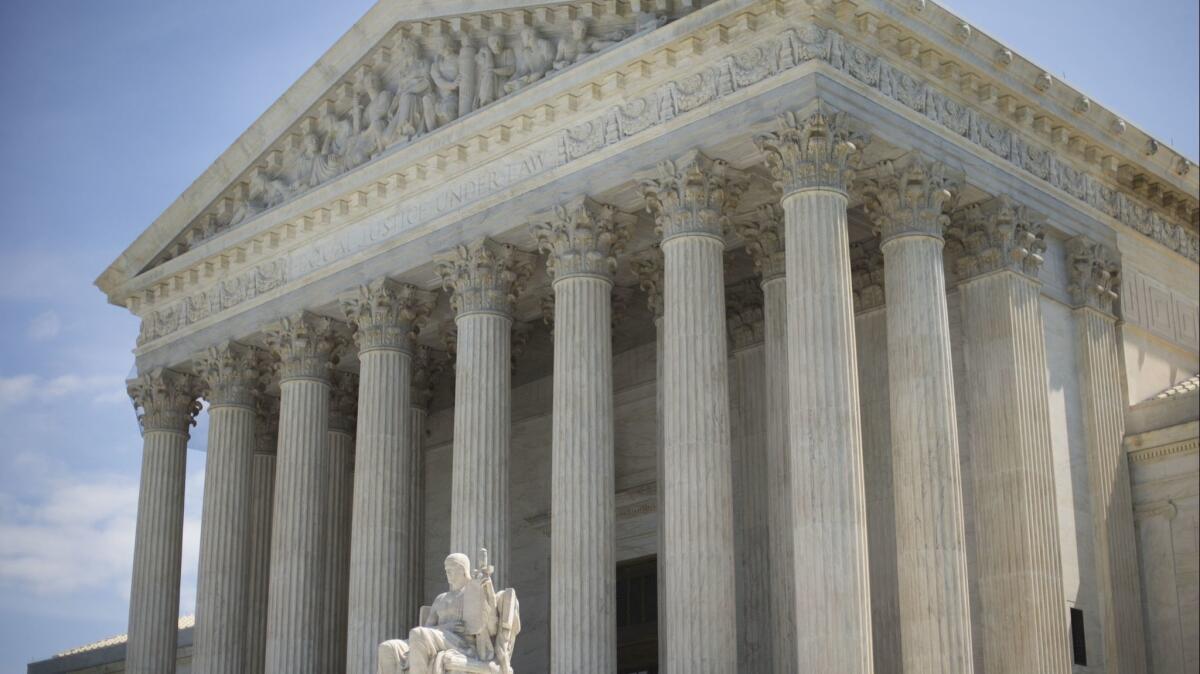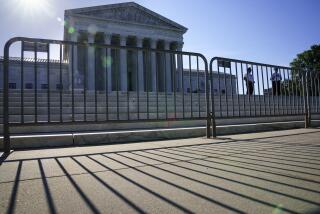Supreme Court opens its new term on a quiet note, amid the loud, partisan dispute over its future

Reporting from Washington — The Supreme Court likes to view itself as the quiet at the center of the storm, and it has never been more so than this week.
The eight justices opened their new term Monday and heard arguments on whether a tiny endangered frog that lives only in Mississippi may also have a protected “critical habitat” on forest land in Louisiana. Weyerhaeuser, a large timber company and wood manufacturer, argues the court should limit the definition of protected habitat to the areas where an endangered species now lives.
Meanwhile, just a block away, the Senate is tied up in a fierce political dispute over whether Judge Brett Kavanaugh should be confirmed to fill the court’s ninth seat. Kavanaugh’s partisan attacks last week against Democrats — who pushed for an FBI probe into decades-old sexual assault allegations against him — threatened to undermine the Supreme Court’s effort to appear independent and above politics.
Chief Justice John G. Roberts Jr. has repeatedly argued the public has the wrong impression of the court. “We don’t work as Democrats or as Republicans,” he said in a 2016 talk in Boston. But he conceded that highly partisan confirmation fights only contribute to the view that the justices themselves are driven by politics.
The fight over Kavanaugh has divided largely along party lines. Senate Republicans said President Trump’s nominee was being sabotaged by allegations that could have been investigated earlier if they had not been held in confidence by Sen. Dianne Feinstein (D-Calif.). Democrats said it would be a historic mistake to confirm a jurist for a lifetime seat on the high court without thoroughly investigating serious charges against him, including Christine Blasey Ford’s allegation that a 17-year-old Kavanaugh assaulted her.
When the justices emerged from behind the red curtain at 10 a.m. Monday, all but Roberts had moved to new seats, reflecting the retirement of Justice Anthony Kennedy. Justice Clarence Thomas is now the longest-serving justice, and he sat to the left side of the chief justice, looking from the audience. On his right now is Justice Ruth Bader Ginsburg, who the chief justice said was marking her 25th anniversary on the court.
As usual, the court’s opening day began with an orders list in which more than a thousand appeal petitions were denied without comment. They had piled up over the summer and were disposed of after justices met for the first time early last week.
Among the rejected appeals was a property-rights challenge to California’s coastal development permits from a Silicon Valley billionaire who sought to close the access road to secluded Martins Beach near Half Moon Bay.
Over the next two months, the court will hear mostly low-profile cases, but several could yield significant rulings.
On Wednesday, the justices will consider whether to overturn a 1980s-era precedent that prevents land owners from suing directly in federal court alleging that local or state zoning rules deny them fair use of their property under the Constitution. In Knick vs. Scott Township, a Pennsylvania woman sued after she was told she had to open her back lot to visitors because a newly discovered burial plot was there. But lower federal courts tossed out her claim on the grounds that she had not worked her way first through the Pennsylvania state courts. Legal experts say that if the high court were to agree with her claim, it could have a major impact in California because it could bolster property rights claims and send them directly to federal courts.
On Oct. 10, the court will review a class-action suit from California to decide whether federal agents can arrest and jail legal immigrants who have past criminal charges on their records, including drug possession. The 9th Circuit Court rejected this mandatory-detention policy and said these detainees can go free after a bond hearing if they are not likely to flee and do not present a danger to the public. But in Nielsen vs. Preap, the Trump administration urges the court to uphold mandatory detention.
And several major cases are on their way to the court later in this term.
They include the dispute over whether President Trump has the authority to end the Obama-era order that shielded the so-called Dreamers from deportation. Judges have blocked Trump’s repeal from taking effect and the high court is awaiting a ruling on the issue from the 9th Circuit Court.
The justices are also likely to consider in the year ahead whether the administration can restrict transgender people from serving in the U.S. military and whether the 2020 census should include a new question on citizenship. California and other states with large immigrant populations oppose this change, arguing it will dissuade people from being counted.
More stories from David G. Savage »
Twitter: DavidGSavage
UPDATES:
1 p.m.: This article was updated with more background and details about upcoming cases.
This article was originally published at 7:40 a.m.
More to Read
Get the L.A. Times Politics newsletter
Deeply reported insights into legislation, politics and policy from Sacramento, Washington and beyond. In your inbox three times per week.
You may occasionally receive promotional content from the Los Angeles Times.











